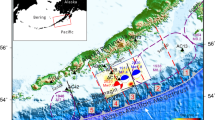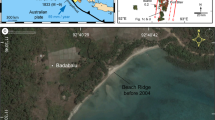Abstract
An interpretation of the occurrence conditions and source parameters is proposed for the catastrophic earthquake of December 26, 2004, in the northwestern part of the Sunda island arc. The interpretation is based on the analysis of spatial distributions of aftershock epicenters and regions subjected to destructive tsunamis, seismicity manifestations in the NW part of the Sunda island arc in the past century, and locations of large tsunami sources of historical earthquakes off the Sumatra Island coast. The source parameters of the December 26, 2004, earthquake are compared with the reliably established main characteristics of sources of the largest tsunamigenic earthquakes in island arcs of the Pacific Ocean. According to the proposed interpretation, the December 26, 2004, earthquake source is a steep reverse fault striking NW and dipping toward the Indian Ocean. The source, ∼450 km long, is located in front of the NW termination of Sumatra Island, in the southern part of the Nicobar Islands. Possible positions and sizes of large potential seismic sources in the NW part of the Sunda island arc are suggested.
Similar content being viewed by others
References
K. Abe, “Tsunami Magnitude and the Quantification of Earthquake Tsunamis around Japan, Bull. Earthq. Res.” Ins. Univ. Tokyo 63, Part 3, 289–803 (1988).
P. St. Amand, “Circum-Pacific Orogeny,” Publ. Dom. Observ. Ottawa 29(2), 403–411 (1957).
Ch. J. Ammon, Ch. Ji, Thio Hong-Kie, et al., “Rupture Process of the 2004 Sumatra-Andaman Earthquake,” Science 308(5725), 1133–1139 (2005).
V. A. Aprodov, Volcanoes (Mysl’, Moscow, 1982) [in Russian].
L. M. Balakina, “Relationship of Tsunami Generation and Earthquake Mechanism in the Northwestern Pacific,” in Tsunamis in the Pacific Ocean (Honolulu East-West Center Press, 1969), pp. 47–55.
L. M. Balakina, “Tsunami and the Focal Mechanism of Earthquakes in the NW Pacific Ocean,” in Tsunami Waves (SakhKNII, Yuzhno-Sakhalinsk, 1972), pp. 48–72 [in Russian].
L. M. Balakina, “The Aleutian Earthquakes of 1957 and 1965”, Izv. Akad. Nauk SSSR, Fiz. Zemli, No. 6, 12–28 (1974).
L. M. Balakina, “Strong Earthquakes of 1974–1975 in the Southern Kurile Island Arc: Processes in Sources,” Izv. Akad. Nauk SSSR, Fiz. Zemli, No. 8, 3–19 (1983).
L. M. Balakina, “The Generation Order of Earthquakes in the Lithosphere of the Southern Half of the Kurile Island Arc,” Dokl. Akad. Nauk SSSR 304(5), 1092–1096 (1989).
L. M. Balakina, “Structure of the Southern Kurile Seismogenic Zone and the Earthquake Generation Order in this Zone,” Izv. Akad. Nauk SSSR, Fiz. Zemli, No. 1, 35–48 (1991a).
L. M. Balakina, “On the Origin of Tectonic Movements in Island Arcs,” Byull. Mosk. O-va Ispyt. Prir., Otd. Geol. 66(1), 3–12 (1991b).
L. M. Balakina, “The Kamchatka Earthquake of November 4, 1952, and Its Position in Coseismic Deformations in the Kurile-Kamchatka Zone,” Fiz. Zemli, No. 6, 3–19 (1992).
L. M. Balakina, “Kurile-Kamchatka Seismogenic Zone: The Structure and the Generation order of Earthquakes,” Fiz. Zemli, No. 12, 48–57 (1995).
L. M. Balakina, “The October 4, 1994 Shikotan and December 5, 1997 Kronotski Earthquakes and Their Strongest Aftershocks As Regular Manifestations of the Tectonic Process in the Kurile-Kamchatka Seismogenic Zone,” Fiz. Zemli, No. 11, 11–27 (2000) [Izvestiya, Phys. Solid Earth 36, 903–918 (2000)].
L. M. Balakina, “Subduction and Focal Mechanisms of Earthquakes,” in Debatable Aspects of Plate Tectonics and Possible Alternatives (IFZ RAN, Moscow, 2002), pp. 120–141 [in Russian].
L. M. Balakina, A. I. Zakharova, A. G. Moskvina, and L. S. Chepkunas, “Focal Mechanisms of Strong Earthquakes of 1968–1979 in the Northern Lut Zone (Iran) and Their Geological Interpretation,” Fiz. Zemli, No. 6, 13–25 (1995).
L. M. Balakina and A. G. Moskvina, “Large Earthquakes East of the Northern Caucasus: Focal Mechanisms and Their Geological Interpretation,” Fiz. Zemli, No. 5, 21–35 (1997) [Izvestiya, Phys. Solid Earth 33, 358–371 (1997)].
L. M. Balakina and A. G. Moskvina, “The North Anatolian Seismogenic Zone: 1. Regular Patterns of Seismic Manifestations Due to Geological Parameters,” Fiz. Zemli, No. 8, 20–49 (2002) [Izvestiya, Phys. Solid Earth 38, 649–668 (2002)].
L. M. Balakina and A. G. Moskvina, “A Consistent Genetic Relation between Seismic and Geological Parameters,” in Geophysical Investigations (OIFZ RAN, Moscow, 2003), pp. 101–110 [in Russian].
L. M. Balakina and A. G. Moskvina, “Seismogenic Zones of Eastern Anatolia and the Dead Sea Rift: Probable Locations of Future Large Earthquakes,” Fiz. Zemli, No. 12, 10–30 (2004) [Izvestiya, Phys. Solid Earth 40, 972–990 (2004)].
P. Banerjee, F. F. Pollitz, and R. Bürgmann, “The Size and Duration of the Sumatra-Andaman Earthquake from Far-Field Static Offsets,” Science 308(5729), 1769–1772 (2005).
H. Benioff, “Orogenesis and Deep Crustal Structure—Additional Evidence from Seismology,” Bull. Geol. Soc. Am. 65(5), 385–400 (1954).
R. N. Burymskaya, Spectral and Time Characteristics of P Waves from Tsunamigenic Earthquakes from Records of the Obninsk Frequency-Selective Seismic Station (Novo-Aleksandrovsk, 1979) [in Russian].
R. N. Burymskaya, Focal Mechanisms of Tsunamigenic Earthquakes in the Kurile-Kamchatka Zone, Extended Abstract of Cand. Sci. (Phys.-Math.), Moscow, 1980, p. 17.
R. N. Burymskaya and N. A. Zhbrykunova, “Spectral and Time Characteristics of P Waves from Records of the Obninsk Frequency-Selective Seismic Station,” in Propagation of Tsunami Waves and Their Arrival at the Coast (Nauka, Moscow, 1981), pp. 172–186 [in Russian].
R. N. Burymskaya, B. V. Levin, and S. L. Solov’ev, “A Kinematic Criterion for the Tsunami Potential of a Submarine Earthquake,” Dokl. Akad. Nauk SSSR 261(6), 1325–1329 (1981).
Evolution of Tsunami from the Source to the Shore (Radio i Svyaz’, Moscow, 1982) [in Russian].
Excitation and Propagation of Tsunami (Inst. Okeanol. AN SSSR, Moscow, 1982) [in Russian].
S. A. Fedotov, “Localization of Tsunami Generation Areas Associated with the Kamchatka, November 4, 1952, and Iturup, November 6, 1958, Earthquakes,” Izv. Akad. Nauk SSSR, Ser. Geofiz., No. 10, 1333–1339 (1962).
Generation of Tsunami Waves and Their Arrival at the Coast (Radio i Svyaz’, Moscow, 1984) [in Russian].
V. K. Gusyakov, Numerical Modeling of Tsunami and Seismoacoustic Waves from Earthquakes in Ocean, Cand. Sci. (Phys.-Math.) Dissertation, Novosibirsk, 1974a.
V. K. Gusyakov, “Tsunami Waves in Relation to Source Parameters of a Submarine Earthquake,” in Mathematical Problems in Geophysics (VTs SO AN SSSR, Novosibirsk, 1974b) [in Russian].
B. Gutenberg and C. F. Richter, Seismicity of the Earth and Associated Phenomena (New York, 1965).
M. Hamada, M. Kitahara, K. Nakagava, and T. Ando, “The Mid-Sea of Japan Earthquake of May 16, 1983 and Numerical Analysis of the Tsunami,” Soil Dynam. Earthq. Eng. 7(3), 123–135 (1988).
T. Hatori, “Vertical Displacement in a Tsunami Source Area and the Topography of the Sea Bottom,” Bull. Earthq. Res. Inst. Univ. Tokyo 44, part 4, 1449–1464 (1966).
T. Hatori, “Vertical Crustal Deformation and Tsunami Energy,” Bull. Earthq. Res. Inst. Univ. Tokyo 48, part 2, 171–188 (1970).
T. Hatori, “Tsunami Behaviors in the Seto Inland Sea and Bungo Channel Caused by the Nakaido Earthquakes in 1707, 1854, and 1946,” J. Seismol. Soc. Japan 41(2), 215–221 (1988).
K. Iida, “The Generation of Tsunamis and the Focal Mechanism of Earthquakes,” in Tsunamis in the Pacific Ocean (Honolulu, 1969), pp. 3–18.
International Seismological Summary. 1935. October, November, December (Univ. Observ., Oxford, 1946), pp. 673–689.
International Seismological Summary for 1941 (Kew Observ., Richmond, 1952) pp. 246–261.
Th. Lay, H. Kanamori, Ch. J. Ammon, et al., “The Great Sumatra-Andaman Earthquake of 26 December, 2004,” Science 308(5725), 1127–1133 (2005).
E. Marris, “Inadequate Warning System Left Asia at the Mercy of Tsunami,” Nature 7021, 3–5 (2005).
S. Ni and H. Kanamori, “Energy Radiation from the Sumatra Earthquake,” Nature 434(7053), 582 (2005).
New Catalog of Strong Earthquakes in the USSR (Nauka, Moscow, 1977) [in Russian].
J. Park, Song Teh-RuAlex, J. Tromp, et al., “Earth’s Free Oscillations Excited by the 26 December, 2004 Sumatra-Andaman Earthquake,” Science 308(5725), 1139–1144 (2005).
Propagation of Tsunami Waves and Their Arrival at the Shore (Nauka, Moscow, 1981) [in Russian].
C. F. Richter, Elementary Seismology (Freeman, San-Francisco, 1958).
Y. P. Rothe, The Seismicity of the Earth. 1953–1965 (UNESCO, 1969).
Q. Schiermeir, “On the Trail of Destruction,” Nature 433(7024), 350–353 (2005).
E. I. Shirokova, “Stresses and Ruptures in Earthquake Sources of the Mediterranean-Asian Seismic Belt,” in The Elastic Stress Field of the Earth and Focal Mechanisms of Earthquakes (Nauka, Moscow, 1972), pp. 112–147 [in Russian].
K. Sieh, “What Happened and What’s Next?,” Nature 434(7053), 573–574 (2005).
S. L. Solov’ev, “Earthquake and Tsunami Recurrence in the Pacific Ocean,” in Tsunami Waves (SakhKNII, Yuzhno-Sakhalinsk, 1972), pp. 7–47 [in Russian].
S. L. Solov’ev, “Major Data on Tsunami at the Pacific Coast of the USSR over 1737–1976,” in Study of Tsunami in Open Ocean (Nauka, Moscow, 1978), pp. 61–136 [in Russian].
S. L. Solov’ev and Ch. N. Go, Catalog of Tsunamis off the Western Pacific Coast (Nauka, Moscow, 1974) [in Russian].
S. L. Solov’ev and Ch. N. Go, A Map Showing Tsunami Sources and Heights in the Pacific Ocean (GUGK, Moscow, 1977) [in Russian].
S. L. Solov’ev and R. N. Burymskaya, “Estimating New Criteria of the Tsunami Potential of Earthquakes,” Izv. Akad. Nauk SSSR, Fiz. Zemli, No. 8, 25–40 (1981).
S. L. Solov’ev, Ch. N. Go, and Kh. S. Kim, Catalog of Tsunami in the Pacific Ocean over 1969–1982 (Mezhduvedom. Geofiz. Komitet AN SSSR, Moscow, 1986) [in Russian].
S. L. Solov’ev, S. A. Kovalev, and Yu. F. Kopnichev, “Improving the Effectiveness of Tsunami Prediction,” Izv. Akad. Nauk SSSR, Fiz. Zemli, No. 1, 35–45 (1987).
S. Stein and E. Okal, “Speed and Size of the Sumatra Earthquake,” Nature 434(7053), 581–582 (2005).
Study of Tsunami in Open Ocean (Nauka, Moscow, 1978) [in Russian].
Theory and On-Line Prediction of Tsunami (Nauka, Moscow, 1980) [in Russian].
Tsunamis in the Pacific Ocean (East-West Center Press, Honolulu, 1969].
Tsunami Waves (SakhKNII, Yuzhno-Sakhalinsk, 1972) [in Russian].
H. Watanabe, “Statistical Studies of Tsunami Sources and Tsunamigenic Earthquakes Occurring in and Near Japan,” in Tsunamis in the Pacific Ocean East-West Center Press, Honolulu, 1969), pp. 99–117.
Author information
Authors and Affiliations
Additional information
Original Russian Text © L.M. Balakina, 2006, published in Fizika Zemli, 2006, No. 5, pp. 25–46.
Rights and permissions
About this article
Cite this article
Balakina, L.M. The seismic catastrophe of December 26, 2004, in the Indian Ocean as a tsunamigenic earthquake in island arc structures. Izv., Phys. Solid Earth 42, 377–397 (2006). https://doi.org/10.1134/S106935130605003X
Received:
Issue Date:
DOI: https://doi.org/10.1134/S106935130605003X




